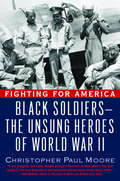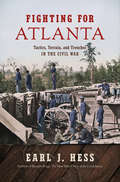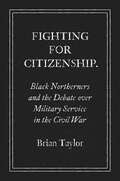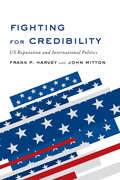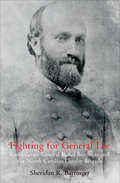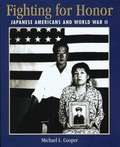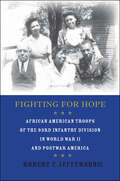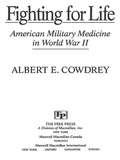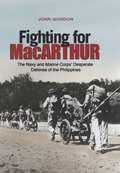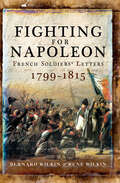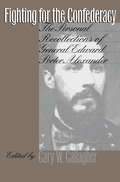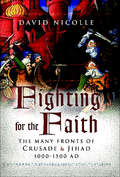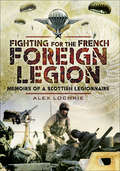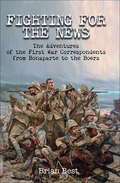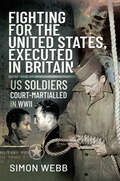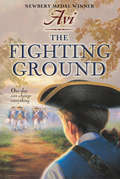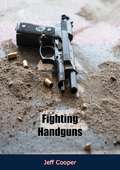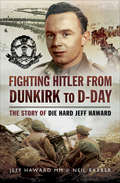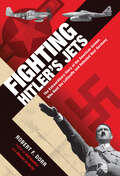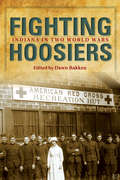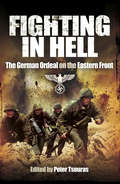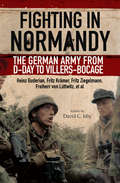- Table View
- List View
Fighting for America: Black Soldiers-the Unsung Heroes of World War II
by Christopher Paul MooreThe African-American contribution to winning World War II has never been celebrated as profoundly as in Fighting for America. In this inspirational and uniquely personal tribute, the essential part played by black servicemen and -women in that cataclysmic conflict is brought home. Here are letters, photographs, oral histories, and rare documents, collected by historian Christopher Moore, the son of two black WWII veterans. Weaving his family history with that of his people and nation, Moore has created an unforgettable tapestry of sacrifice, fortitude, and courage. From the 1,800 black soldiers who landed at Normandy Beach on D-Day, and the legendary Tuskegee Airmen who won ninety-five Distinguished Flying Crosses, to the 761st Tank Battalion who, under General Patton, helped liberate Nazi death camps, the invaluable effort of black Americans to defend democracy is captured in word and image. Readers will be introduced to many unheralded heroes who helped America win the war, including Dorie Miller, the messman who manned a machine gun and downed four Japanese planes; Robert Brooks, the first American to die in armored batt Lt. Jackie Robinson, the future baseball legend who faced court-martial for refusing to sit in the back of a military bus; an until now forgotten African-American philosopher who helped save many lives at a Japanese POW c& even the author's own parents: his mother, Kay, a WAC when she met his father, Bill, who was part of the celebrated Red Ball Express. Yet Fighting for America is more than a testimonial; it is also a troubling story of profound contradictions, of a country still in the throes of segregation, of a domestic battleground where arrests and riots occurred simultaneously with foreign service-and of how the war helped spotlight this disparity and galvanize the need for civil rights. Featuring a unique perspective on black soldiers, Fighting for America will move any reader: all who, like the author, owe their lives to those who served.
Fighting for Atlanta: Tactics, Terrain, and Trenches in the Civil War (Civil War America)
by Earl J. HessAs William T. Sherman's Union troops began their campaign for Atlanta in the spring of 1864, they encountered Confederate forces employing field fortifications located to take advantage of rugged terrain. While the Confederates consistently acted on the defensive, digging eighteen lines of earthworks from May to September, the Federals used fieldworks both defensively and offensively. With 160,000 troops engaged on both sides and hundreds of miles of trenches dug, fortifications became a defining factor in the Atlanta campaign battles. These engagements took place on topography ranging from Appalachian foothills to the clay fields of Georgia's piedmont.Leading military historian Earl J. Hess examines how commanders adapted their operations to the physical environment, how the environment in turn affected their movements, and how Civil War armies altered the terrain through the science of field fortification. He also illuminates the impact of fighting and living in ditches for four months on the everyday lives of both Union and Confederate soldiers. The Atlanta campaign represents one of the best examples of a prolonged Union invasion deep into southern territory, and, as Hess reveals, it marked another important transition in the conduct of war from open field battles to fighting from improvised field fortifications.
Fighting for Citizenship: Black Northerners and the Debate over Military Service in the Civil War (Civil War America)
by Brian TaylorIn Fighting for Citizenship, Brian Taylor complicates existing interpretations of why black men fought in the Civil War. Civil War–era African Americans recognized the urgency of a core political concern: how best to use the opportunity presented by this conflict over slavery to win abolition and secure enduring black rights, goals that had eluded earlier generations of black veterans. Some, like Frederick Douglass, urged immediate enlistment to support the cause of emancipation, hoping that a Northern victory would bring about the end of slavery. But others counseled patience and negotiation, drawing on a historical memory of unfulfilled promises for black military service in previous American wars and encouraging black men to leverage their position to demand abolition and equal citizenship. In doing this, they also began redefining what it meant to be a black man who fights for the United States.These debates over African Americans' enlistment expose a formative moment in the development of American citizenship: black Northerners' key demand was that military service earn full American citizenship, a term that had no precise definition prior to the Fourteenth Amendment. In articulating this demand, Taylor argues, black Northerners participated in the remaking of American citizenship itself—unquestionably one of the war's most important results.
Fighting for Credibility: US Reputation and International Politics
by Frank P. Harvey John MittonWhen Bashar al-Assad used chemical weapons against his own people in Syria, he clearly crossed President Barack Obama’s "red line." At the time, many argued that the president had to bomb in order to protect America's reputation for toughness, and therefore its credibility, abroad; others countered that concerns regarding reputation were overblown, and that reputations are irrelevant for coercive diplomacy. Whether international reputations matter is the question at the heart of Fighting for Credibility. For skeptics, past actions and reputations have no bearing on an adversary’s assessment of credibility; power and interests alone determine whether a threat is believed. Using a nuanced and sophisticated theory of rational deterrence, Frank P. Harvey and John Mitton argue the opposite: ignoring reputations sidesteps important factors about how adversaries perceive threats. Focusing on cases of asymmetric US encounters with smaller powers since the end of the Cold War including Bosnia, Kosovo, Iraq, and Syria, Harvey and Mitton reveal that reputations matter for credibility in international politics. This dynamic and deeply documented study successfully brings reputation back to the table of foreign diplomacy.
Fighting for General Lee: Confederate General Rufus Barringer and the North Carolina Cavalry Brigade
by Sheridan R. BarringerRufus Barringer fought on horseback through most of the Civil War with General Lees Army of Northern Virginia, and rose to lead the North Carolina Cavalry Brigade in some of the wars most difficult combats. Fighting for General Lee: Confederate General Rufus Barringer and the North Carolina Cavalry Brigade details his entire history for the first time.Barringer raised a company early in the war and fought with the 1st North Carolina Cavalry from the Virginia peninsula through Second Manassas, Sharpsburg, Fredericksburg, and Chancellorsville. He was severely wounded in the face at Brandy Station, during the opening hours of the Gettysburg Campaign. Because of his severe wound, he missed the remainder of the Gettysburg Campaign, returning to his regiment in mid-October, 1863. Within three months he was a lieutenant colonel, and by June 1864 a brigadier general in command of the North Carolina Brigade, which fought the rest of the war with Lee and was nearly destroyed during the retreat from Richmond in 1865. The captured Barringer met President Lincoln at City Point, endured prison, and after the war did everything he could to convince North Carolinians to accept Reconstruction and heal the wounds of war.Fighting for General Lee by Sheridan R. Barringer draws upon a wide array of newspapers, diaries, letters, and previously unpublished family documents and photographs, as well as other firsthand accounts, to paint a broad, deep, and colorful portrait of an overlooked Southern cavalry commander. Despite its subject matter, the book is a balanced account that concludes Barringer was a dependable, hard-hitting warrior increasingly called upon to lead attacks against superior Union forces.This remarkable new biography teaches us many things. It is easy today to paint all who wore Confederate gray with a broad brush because they fought on the side to preserve slavery. Here, however, was a man who wielded the sword and then promptly sheathed it to follow a bolder vision. Barringer proved to be a bold champion of the poor, the black, and the massesa Southern gentleman and man decades ahead of his time that made a difference in the lives of North Carolinians.
Fighting for Honor: Japanese Americans and World War II
by Michael L. CooperAn account of Japanese Americans in World War II, based mainly on diaries, autobiographies, and the military records of the 442nd Regimental Combat Team, which was known as the Purple Heart Battalion because of its bravery. After the attack on Pearl Harbor in 1941, all people on the West Coast of Japanese heritage, whether resident aliens or citizens, were forced to move into internment camps. But 1,200 young men from the camps, along with 10,000 other GIs of Japanese heritage, became some of the most decorated soldiers in the war as part of the 442nd. Author Michel L. Cooper tells of the remarkable bravery of these Nisei soldiers, whose heroism in battles in Europe contrasted with the prejudice that Japanese Americans faced at home.
Fighting for Hope: African American Troops of the 93rd Infantry Division in World War II and Postwar America (War/Society/Culture)
by Robert F. JeffersonThis fascinating history shows how African-American military men and women seized their dignity through barracks culture and community politics during and after World War II.Drawing on oral testimony, unpublished correspondence, archival records, memoirs, and diaries, Robert F. Jefferson explores the curious contradiction of war-effort idealism and entrenched discrimination through the experiences of the 93rd Infantry Division. Led by white officers and presumably unable to fight—and with the army taking great pains to regulate contact between black soldiers and local women—the division was largely relegated to support roles during the advance on the Philippines, seeing action only later in the war when U.S. officials found it unavoidable. Jefferson discusses racial policy within the War Department, examines the lives and morale of black GIs and their families, documents the debate over the deployment of black troops, and focuses on how the soldiers’ wartime experiences reshaped their perspectives on race and citizenship in America. He finds in these men and their families incredible resilience in the face of racism at war and at home and shows how their hopes for the future provided a blueprint for America’s postwar civil rights struggles.Integrating social history and civil rights movement studies, Fighting for Hope examines the ways in which political meaning and identity were reflected in the aspirations of these black GIs and their role in transforming the face of America.
Fighting for Hope: African American Troops of the 93rd Infantry Division in World War II and Postwar America (War, Society, Culture Ser.)
by Robert F. Jefferson“A rigorously researched, richly etched re-creation of the formation of the all-black Ninety-third Infantry Division, which fought in the Pacific theater.” —Journal of American HistoryThis fascinating history shows how African-American military men and women seized their dignity through barracks culture and community politics during and after World War II.Drawing on oral testimony, unpublished correspondence, archival records, memoirs, and diaries, Robert F. Jefferson explores the curious contradiction of war-effort idealism and entrenched discrimination through the experiences of the 93rd Infantry Division. Led by white officers and presumably unable to fight—and with the army taking great pains to regulate contact between black soldiers and local women—the division was largely relegated to support roles during the advance on the Philippines, seeing action only later in the war when U.S. officials found it unavoidable.Jefferson discusses racial policy within the War Department, examines the lives and morale of black GIs and their families, documents the debate over the deployment of black troops, and focuses on how the soldiers’ wartime experiences reshaped their perspectives on race and citizenship in America. He finds in these men and their families incredible resilience in the face of racism at war and at home and shows how their hopes for the future provided a blueprint for America’s postwar civil rights struggles.Integrating social history and civil rights movement studies, Fighting for Hope examines the ways in which political meaning and identity were reflected in the aspirations of these black GIs and their role in transforming the face of America.“A marvelous book.” —Annals of Iowa
Fighting For Life: American Military Medicine in World War II
by Albert E. CowdreyFought on almost every continent, the Second World War confronted American GIs with unprecedented threats to life and health posed by combat on Arctic ice floes and African deserts, steamy island jungles and remote mountain villages, the stratosphere and the depths of the sea. Service men were assaulted by frostbite, malaria, shrapnel, and landmines. But the demands of war provoked unparalleled medical advances in the years 1941-45, as well. In a war that unleashed the technology of destruction as no previous conflict had, the tale of those whose duty it was to save lives in World War II, not destroy them, has remained untold. Now, award-winning author Albert Cowdrey has written the first comprehensive history of one of the most important yet underappreciated weapons of World War II - America's extraordinary military medicine. Cowdrey tells the remarkable story of how American units developed and implemented new technology under dire pressures, succeeding so brilliantly that World War II became the first American war in which more men died in combat than of disease. Penicillin brought the antibiotic revolution to the battlefield, air evacuation plucked the wounded from jungles and deserts, and a unique system brought blood, still fresh from America, to our soldiers all over the world. Surgeons working just behind the front lines stabilized the worst cases, while physicians and public health experts suppressed epidemics and cured exotic diseases. Psychiatrists, nurses and medics all performed heroic feats amidst unspeakable conditions. Together, these men and women improvised medical miracles on the battlefield that could not have been imagined by practitioners in peacetime. Cowdrey recalls those triumphant years when Americans, blessed with the skill, courage, and dedication of a formidable medical fighting force, achieved a spectacular victory.
Fighting for MacArthur
by John GordonAs the only single-volume work to offer a full account of Navy and Marine Corps actions in the Philippines during World War II, this book provides a unique source of information on the early part of the war. Based on a rich collection of American and newly discovered Japanese sources, it is filled with never-before-published details about the fighting, including a revealing discussion of the buildup of tensions between Gen. Douglas MacArthur and the Navy that continued for the remainder of the war.Gordon describes in considerable detail the unusual missions of the Navy and Marine Corps in the largely Army campaign, where sailors fought as infantrymen alongside their Marine comrades at Bataan and Corregidor, crews of Navy ships manned the Army's heavy coastal artillery weapons, and Navy submarines desperately tried to supply the men with food and ammunition. Indeed, this book gives the most detailed account ever published of the Japanese bombing of the Cavite Navy Yard outside Manila on the third day of the war-the worst damage inflicted on a U.S. Navy installation since the British burned the Washington Navy Yard in 1814. It also closely examines the surrender of the 4th Marines at Corregidor, the only time in history that the U.S. Marine Corps lost a regiment in combat. To provide readers with a Japanese perspective of the fighting, Gordon draws on the recently discovered diary of a leader of the Japanese amphibious assault force that fought against the Navy's provisional infantry battalion on southern Bataan, and he also makes full use of the U.S. ship logs and the 4th Marine unit diary that were evacuated from Manila Bay shortly before U.S. forces surrendered.
Fighting for Napoleon: French Soldiers' Letters, 1799–1815
by Bernard Wilkin René WilkinTrue, first-hand accounts of combat and soldiering from the men who fought for Napoleon Bonparte and the First French Empire: &“Fascinating stuff&” (Stuart Asquith, author of Military Modelling). The French side of the Napoleonic Wars is often presented from a strategic point of view, or in terms of military organization and battlefield tactics, or through officers&’ memoirs. Fighting for Napoleon:French Soldiers&’ Letters, 1799–1815, based on more than sixteen hundred letters written by French soldiers of the Napoleonic armies, shares the perspectives and experiences of the lowest, ordinary ranks of the army who fought on the frontlines. Authors Bernard Wilkin and René Wilkin provide an informative read of common soldiers&’ lives for military and cultural historians as well as a fascinating counterpoint to the memoirs of Cpt. Jean-Roch Coignet, Col. Marcellin de Marbot, or Sgt. Adrien Bourgogne. &“A superb guide to the experience and motivation of military service that is based on a wide trawl of relevant letters . . . A first-rate work that is of much wider significance.&” —Professor Jeremy Black, author of The Battle of Waterloo &“Provides the reader with a good insight into the lives of ordinary French of the Napoleonic Wars . . . Direct accounts of campaigns and battle, recruitment and training, barrack life, the experience of captivity and being wounded are all here, based on letters written most by uneducated men to their immediate family . . . This really is fascinating stuff, and surely a &‘must&’ for students of Napoleonic warfare.&” —Stuart Asquith, author of Military Modelling: Guide to Solo Wargaming
Fighting for the Confederacy
by Gary W. GallagherOriginally published by UNC Press in 1989, Fighting for the Confederacy is one of the richest personal accounts in all of the vast literature on the Civil War. Alexander was involved in nearly all of the great battles of the East, from First Manassas through Appomattox, and his duties brought him into frequent contact with most of the high command of the Army of Northern Virginia, including Robert E. Lee, Stonewall Jackson, and James Longstreet. No other Civil War veteran of his stature matched Alexander's ability to discuss operations in penetrating detail-- this is especially true of his description of Gettysburg. His narrative is also remarkable for its utterly candid appraisals of leaders on both sides.
Fighting for the Faith: The Many Fronts of Crusade & Jihad 1000-1500 AD
by David NicolleFighting between Christians and Muslims in the medieval period is often seen in the narrow context of the battle for the Holy Land. Other points of conflict tend to be ignored. But, as David Nicolle's thought-provoking survey shows, the religions clashed across the medieval world - in the Mediterranean and the Iberian peninsula, in the Near East, in Central Asia, India, the Balkans, Anatolia, Russia, the Baltic and Africa. Over 500 years, the struggle in each theatre of conflict had its own character - methods of warfare differed and developed in different ways and were influenced by local traditions and circumstances. And these campaigns were not waged solely against Christian or Islamic enemies, but against pagan, non-Christian or non-Islamic peoples. As he tells the story of Crusade and Jihad, and describes the organization and tactics of the armies involved, David Nicolle opens up a new understanding of the phenomenon of holy war.
Fighting for the French Foreign Legion: Memoirs of a Scottish Legionnaire
by Alex LochrieA soldier’s true story of danger and adventure as a modern-day legionnaire in Kuwait, Bosnia, and beyond. With no French language ability, Alex Lochrie approached recruiters for the French Foreign Legion in Paris and embarked on the demanding selection process that followed. When he was accepted, he and other prospective legionnaires were sent to Southern France to begin the harsh recruit training course. The mix of nationalities and backgrounds among his fellows was enormous. New members are traditionally allowed to change their identities—and Lochrie chose to alter his age, becoming twenty-eight instead of thirty-eight. Elite paratrooper training followed in Corsica before Lochrie earned his wings. The FFL is never far from the front line, and in this book he tells of challenging active service in former French colonies in Africa as well as during the first Gulf War, evicting Saddam Hussein from Kuwait, and operations in Bosnia and Sarajevo. This gripping account lifts the veil of mystery and myth, pulling you into the action—and revealing much about the realities of service in the Foreign Legion.
Fighting for the News: The Adventures of the First War Correspondents from Bonaparte to the Boers
by Brian BestThe incredible true stories of the first reporters from the battlefield—from Europe&’s Napoleonic era to the Boer Wars of South Africa. Over two centuries ago, newspapers first considered sending a reporter overseas to observe, gather information, and write about war. With no experience to draw upon, both newspapers and correspondents gradually worked out a procedure that has evolved into today&’s incredibly sophisticated systems of reportage. Here are the gripping accounts of those groundbreaking adventurers who sought out the danger of battle in pursuit of a story. Included within are the exploits of such journalistic luminaries as the first real war correspondent, Henry Crabb Robinson, who was sent by The Times of London to act as their &‘man in Germany&’, ostensibly to follow and report the movements of Napoleon&’s Grande Armée; William Howard Russell in the Crimean War, whose reports helped change the British government&’s treatment of their soldiers; and perhaps the most famous correspondent of all, a young Winston Churchill who reported on conflicts in Cuba, the Indian frontier, Sudan, and the Boer War. For any fan of history, journalism, or true-life adventures, Fighting for the News is all you need to get the full story.
Fighting for the Trauma Doc's Heart: Pacific Paradise, Second Chance / Fighting For The Trauma Doc's Heart (Mills And Boon Medical Ser.)
by Rachel DoveFrom professional rivals…To a family of three?Ex-army doc Jacob Peterson is still adjusting to life as a single dad when his job is threatened by returning trauma doc Michelle Forbes. The sparks of animosity with the smart, sassy doc soon turn to attraction. But there’s room in Jacob’s life for only one girl—his daughter—and he can’t risk her heart, or his, again. Resisting his growing bond with Michelle will be the fight of his life!
Fighting for the United States, Executed in Britain: US Soldiers Court-Martialled in WWII
by Simon WebbThis book relates a chapter of American military history which many people would rather forget. When the United States came to the aid of Britain in 1942, the arrival of American troops was greeted with unreserved enthusiasm, but unfortunately, wartime sometimes brings out the worst, as well as the best, in people. A small number of the soldiers abused the hospitality they received by committing murders and rapes against British civilians. Some of these men were hanged or shot at Shepton Mallet Prison in Somerset, which had been handed over for the use of the American armed forces. Due to a treaty between Britain and America, those accused of such offences faced an American court martial, rather than a British civilian court, which gave rise to some curious anomalies. Although rape had not been a capital crime in Britain for over a century, it still carried the death penalty under American military law and so the last executions for rape in Britain were carried out at this time in Shepton Mallet. Fighting For the United States, Executed in Britain tells the story of every American soldier executed in Britain during the Second World War. The majority of the executed soldiers were either black or Hispanic, reflecting the situation in the United States itself, where the ethnicity of the accused person often played a key role in both convictions and the chances of subsequently being executed.
The Fighting Ground
by AviApril 3, 1778<P><P>He may be just thirteen, but Jonathan knows he's ready to go to the war against the British. He can handle a gun. He yearns to battle for glory, just like his brother and cousin.So when Jonathan hears the tavern bell toll, calling men to fight, he runs to join them. He doesn't realize that in just twenty-four hours, his life will be forever altered -- by the war, by his fellow soldiers, and by the terrible choices he must make. <P><b> Winner of the Scott O'Dell Award for Historical Fiction </b>
Fighting Handguns: History, Adventure And Romance Of Handguns From The Muzzle Loader To Modern Magnums
by Jeff CooperIn Fighting Handguns, author Jeff Cooper not only takes the reader through the development of this weapon from its beginnings in mid-16th-century Europe through the various iterations of single- and double-action revolvers and semiautomatic pistols, he also discusses some important aspects of carrying and shooting a fighting handgun under combat conditions.“For good or ill, man is a fighting animal. While most feel that this is an unmitigated evil, it may, like most aspects of nature, have its positive side. Certainly man’s combative nature is responsible for most of the massive tragedy of history, but it’s possible that history of any sort just wouldn’t have happened had it not been characteristic of the race to struggle against its environment. And man’s environment, of course, includes man. A placid, gentle, contented creature—a koala, for instance—is nice to contemplate but does not progress, and if it encounters a challenge it simply dies. Whether progress, at the price of a fighting disposition, is worth it is a question, but it’s a bit on the academic side. Man is the way he is, and gets along as he must. Being human, we are involved in strife. Much as we may deplore this, we must master the techniques of strife or perish.“This book is devoted to one of these techniques—the one-hand firearm as used by man against man.”—Jeff Cooper
Fighting Hitler from Dunkirk to D-Day: The Story of Die Hard Jeff Haward
by Jeff Haward Neil BarberFighting Hitler From Dunkirk to D-Day is the compelling story of a man belonging to a group of which there are now very few survivors. Jeff Haward MM is a pre-war Territorial Army soldier who enlisted merely for something to do in the evenings. Consequently, he fought throughout the entirety of the Second World War. Jeff is a 'Die Hard', the historic name given to men of the famous Middlesex Regiment. He joined the 1/7th Battalion, a machine-gun battalion, equipped with the British Army's iconic Vickers medium machine gun.Following evacuation from Dunkirk, the 1/7th, while refitting and re-equipping, carried out coastal defence duties in preparation for the German invasion. So desperate was the situation that on sentry duty, the one rifle per section had to be handed to the next sentry, along with the only ammunition available three rounds!In 1941, they were attached to the famous 51st Highland Division. The less than enthusiastic welcome from the Jocks gradually evolved into respect following the Middlesex's performance at El Alamein and the subsequent campaigns in North Africa, Sicily, Normandy and North West Europe.Following the Reichswald battle, in March 1945, Jeff was surprised to hear that he had been awarded the Military Medal for bravery and was subsequently awarded the ribbon by none other than Field Marshal Sir Bernard Montgomery.Jeff Haward's experiences, those of a normal soldier, make fascinating reading and throw new light on the use of such Vickers gun battalions during the war.
Fighting Hitler's Jets: The Extraordinary Story of the American Airmen Who Beat the Luftwaffe and Defeated Nazi Germany
by Robert F. DorrFighting Hitler's Jets brings together in a single, character-driven narrative two groups of men at war: on one side, American fighter pilots and others who battled the secret “wonder weapons” with which Adolf Hitler hoped to turn the tide; on the other, the German scientists, engineers, and pilots who created and used these machines of war on the cutting edge of technology. Written by Robert F. Dorr, renowned author of Zenith Press titles Hell Hawks!, Mission to Berlin, and Mission to Tokyo, the story begins with a display of high-tech secret weapons arranged for Hitler at a time when Germany still had prospects of winning the war. It concludes with Berlin in rubble and the Allies seeking German technology in order to jumpstart their own jet-powered aviation programs. Along the way, Dorr expertly describes the battles in the sky over the Third Reich that made it possible for the Allies to mount the D-Day invasion and advance toward Berlin. Finally, the book addresses both facts and speculation about German weaponry and leaders, including conspiracy theorists’ view that Hitler escaped in a secret aircraft at the war’s end. Where history and controversy collide with riveting narrative, Fighting Hitler’s Jets furthers a repertoire that comprises some of the United States’ most exceptional military writing.
Fighting Hoosiers: Indiana in Two World Wars
by Dawn E. BakkenFighting Hoosiers: Indiana in Two World Wars tells the compelling, heartbreaking, and breathtaking stories of some of the hundreds of thousands of Hoosiers who served their country during the First and Second World Wars. Drawn from the rich holdings of the Indiana Magazine of History, a journal of state and midwestern history published since 1905, the collection includes original diaries, letters and memoirs, as well as research essays—all of them focused on Hoosiers in the two world wars. Readers will meet Alex Arch, a Hungarian-born immigrant who was the first American to fire a shot in World War I; Maude Essig, a nurse serving with the American Red Cross in wartime France; Kenneth Baker, a soldier in the Army Signal Corps, who crawled across French fields (sometimes over and around dead bodies) to lay phone lines for military communications; and Bernard Rice, a combat medic who witnessed the liberation of the Dachau concentration camp in 1945. Indiana's brave men and women like these have served with distinction in the armed forces since the earliest days of the Indiana Territory. Fighting Hoosiers offers a compelling glimpse at some of their remarkable stories.
Fighting in Hell: The German Ordeal on the Eastern Front
by Peter TsourasDetailed reports by German commanders: &“Powerful testimony to the Germans&’ lack of preparation for the harsh climatic conditions of the Russian winter.&” —Military Machines International When their troops invaded the Soviet Union in 1941, the initial success convinced the German high command that the Red Army could be destroyed west of the Dnepr River and that there would be no need for conducting operations in cold, snow, and mud. They were wrong. In fact, the German war in Russia was so brutal in its extremes that all past experience paled beside it. Everything in Russia—the land, the climate, the distances, and above all the people—were harder, harsher, more unforgiving, and deadlier than anything the German soldier had ever faced before. One panzer-grenadier who fought in the West and in Russia summed it up: In the West war was the same honorable old game; nobody went out of his way to be vicious, and fighting stopped often by five in the afternoon. But in the East, the Russians were trying to kill you—all the time. The four detailed reports of campaigning in Russia included in this invaluable book (Russian Combat Methods in WWII, Effects of Climate on Combat in European Russia, Combat in Russian Forests and Swamps and Warfare in the Far North) were written in the late 1940s and early 1950s as part of the US Army program to record the German strategies and tactics of World War II directly from the commanders. The authors were all veterans of the fighting they described, and frankly admitted that the soldiers sent to Russia were neither trained nor equipped to withstand the full fury of the elements. Fighting in Hell shows what happened on the ground, through firsthand accounts of the commanders who were there.
Fighting in Normandy: The German Army from D-Day to Villers-Bocage
by David C. IsbyCollected in-depth accounts from Nazi commanders chronicling their efforts to fight back against the Allied invasion at Normandy during World War II. The Allied landings on the Normandy beaches in June 1944 were brilliantly executed but proved to be just the opening phase of a desperately fought battle. The German Army responded to the invasion with as much ferocity and force as it could muster, and turned the struggle into a brutal and prolonged campaign. These in-depth reports by German commanders given the task of turning the tables on the invaders is crucial to a full understanding of the battle for Normandy. The accounts David Isby has selected, all written soon after the war&’s close for American military intelligence, cover German attempts to stem the invasion, dramatic defensive battles in the Norman countryside and attempts to implement a series of counterattacks. This vital source material presents the German perspective on the fighting, from regimental to corps level, and graphically illustrates the wealth of problems faced by an army on the very brink of destruction.
